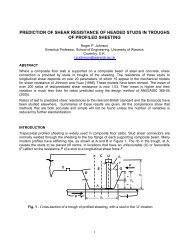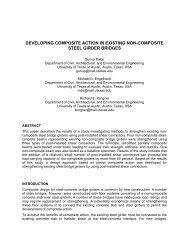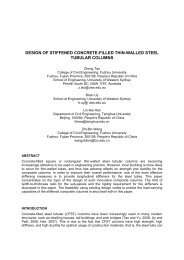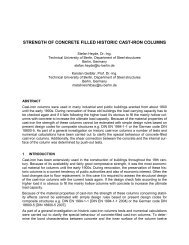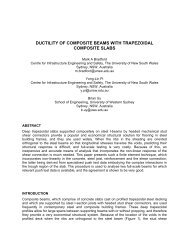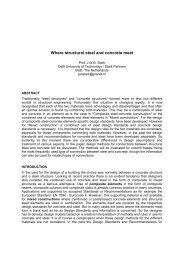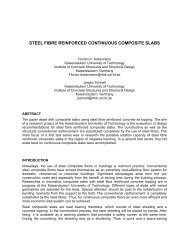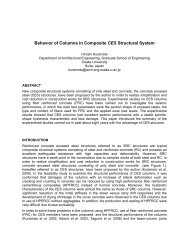concrete - filled steel tube columns - tests ... - CCVI Information
concrete - filled steel tube columns - tests ... - CCVI Information
concrete - filled steel tube columns - tests ... - CCVI Information
Create successful ePaper yourself
Turn your PDF publications into a flip-book with our unique Google optimized e-Paper software.
For circular CFST <strong>columns</strong> enhancement factors (‘eta’ (η) factors, Clause 6.7.3.2(6)) can beapplied to allow for the increase in <strong>concrete</strong> strength caused by the confining effect of the <strong>steel</strong><strong>tube</strong> which produces a triaxial compressive stress state in the <strong>concrete</strong> thus increasing itsfailure load [Hobbs et al 1977]. For rectangular section CFST <strong>columns</strong> the Code takes thefailure stress in the <strong>concrete</strong> as the cylinder strength, without the 0.85 factor that is applied inunrestrained <strong>concrete</strong> to relate the <strong>concrete</strong>’s cylinder strength to its uniaxial strength.Overall buckling is allowed for in the Code by introducing a buckling factor (χ) related to therelative slenderness, λ , by the buckling curve (Clause 6.7.3.5(2)). When there is a moment onthe column two methods of analysis are permitted. A ’simplified’ method in which the secondordereffects (P-Δ effect and member imperfections) are allowed for by multiplying the first-orderapplied moments by a factor ‘k’ (greater than unity) and a more exact method where thesecond-order effect, the lateral deflection due to the end moment, is analysed and allowed for.When comparing with the <strong>tests</strong> the member imperfections have been assumed to be zero andboth the ‘simplified’ and ‘second-order’ methods have been used to analyse long <strong>columns</strong> withan end moment and the results are included in the database and summarised in Table 1 of thispaper. In the simplified method the calculated strength has been divided by the ‘k’ factor tocompare with the test result (rather than factoring the test result by ‘k’) and the failure loadpredicted by the code is compared with the test result at the same axial load/moment ratio aswas used in the test.DISCUSSION AND COMPARISON WITH EUROCODE 4GeneralIt can be seen from Table 1 that the average failure load in the test divided by the Eurocode 4prediction (Test/EC4) value for each type of column is greater than unity indicating thatEurocode 4 predicts a lower value than the test and thus a ‘safe’ result.Table 1 – Summary of results for each type of column.Type of ColumnNumber of Average St Dev ofTests Test/EC4 Test/EC4Short Circular No Moment 368 1.06 0.091Long Circular No Moment 369 1.17 0.148Long (and a few short) ‘k’ factor method254 1.15 0.111Circular with Moment 2 nd order analysis 254 1.15 0.119Short Rectangular No Moment 330 1.09 0.096Long Rectangular No Moment 212 1.06 0.097Short rectangular with Moment 29 1.01 0.108Long Rectangular ‘k’ factor method96 1.10 0.097with Moment 2 nd order analysis 96 1.20 0.148Short Hollow Circular No Moment 76 1.22 0.095Circular with Moment and Preload on <strong>steel</strong> 23 1.15 0.123Rectangular with Moment and Preload on <strong>steel</strong> 19 1.03 0.099Long Rectangular No Moment with Sustained Load 8 1.25 0.051Square, 8-sided, 16-sided Hollow No Moment 24 1.16 0.108Totals (excluding Biaxial Bending, ‘k’ factor analysis) 1808 1.11 0.108Rectangular with Code straight line interaction 11 1.52 0.058Biaxial Bending Elliptical interaction, α M = 1 11 1.20 0.041




